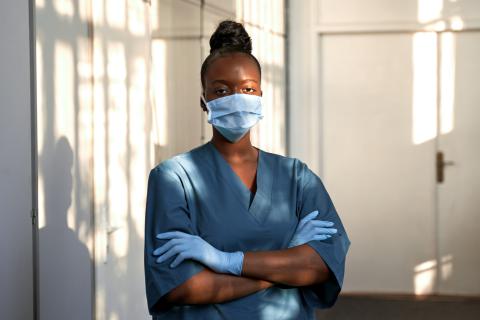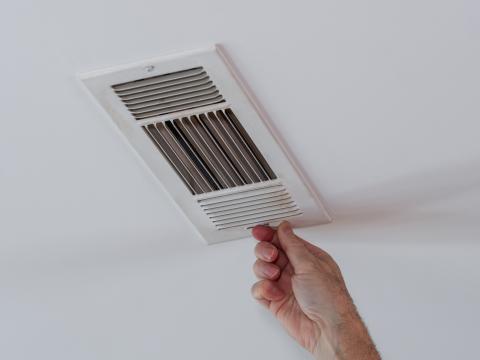Infection Preventionist Starter Kit: Environmental Infection Control
The environment serves as a reservoir for a variety of microorganisms across all health care facilities. Opportunistic pathogens, such as Aspergillus and Legionella, can cause adverse outcomes for patients, residents, visitors, and health care workers. Infection preventionists (IPs) can reduce this risk by monitoring the environment and implementing infection control measures as needed.
IPs should work with a multidisciplinary team, including facilities maintenance and environmental services, to ensure key areas and practices are monitored regularly. These include air handling, water management, laundry practices, animal and pest control, and regulated medical waste management.
Key environmental infection control concepts
Some key environmental infection control concepts for IPs are listed below. In addition to these concepts, infection preventionists should review Environmental Infection Control in Health Care Facilities from the CDC (Centers for Disease Control and Prevention).
Air handling involves monitoring the temperature, humidity, air pressure, and number of air exchanges per hour in a particular space.
IPs should consider:
- Air exchange and pressure: Different types of rooms demand different air exchange rates and positive or negative air pressure. Air pressure relationships should be checked regularly.
- Heating, ventilation, and air conditioning (HVAC) systems: HVAC monitoring frequency varies. Guidance for these standards are from the American Institute of Architects (AIA).
- Humidity levels: Relative humidity levels above 60% promote bacterial and fungal growth. Outbreaks of Aspergillus, Pseudomonas, Staphylococcus aureus, and Acinetobacter have been linked to poorly maintained or malfunctioning air conditioning systems.
- Ventilation systems: Ensure that emergency back-up generators are available to maintain the ventilation system in high-risk areas such as, operating rooms or intensive care units, during power loss.
Facility maintenance staff are often responsible for monitoring air flow and pressure, HVAC systems, and humidity in a facility. They may even have a computerized, or automated system, that monitors this for them. IPs should work with maintenance staff to ensure that these expected practices are occurring, and that staff understand their roles.
Construction, renovation, remediation, repair, and demolition projects require substantial planning and may require an infection control risk assessment (ICRA).
IPs should consider:
- Risk assessment: Engage a multidisciplinary team when performing the risk assessment. The team needs to know details about the project, such as when, where, and scale of the project.
- Construction type and populations at risk: Outline the type of construction and the populations at risk during a risk assessment. A matrix can be utilized for this purpose.
- Facility policy: Ensure policies are in place to identify and respond to water damage in your facility, including prompt removal if wet structural materials cannot be dried within 72 hours. Mold can grow within 72 hours of water damage in drywall, plaster, ceiling tiles, and other structural materials.
IP tip: An eight-hour ICRA training is provided to IPs, facility management staff, and contract workers free of charge by the North Central States Regional Council of Carpenters. Visit their website to find currently available classes, or contact them to set up a training at your facility if interested.
View the IP Lunch and Learn: Construction in Health Care Facilities webinar recording for additional information regarding construction projects.
Water management involves monitoring the facility’s water system to prevent growth and spread of waterborne pathogens, such as Legionella.
CMS (Centers for Medicare & Medicaid Services) requires that health care facilities, such as hospitals and nursing homes, develop and adhere to American Society of Heating, Refrigerating and Air-Conditioning Engineers-compliant water management programs to reduce the risk for Legionella and other pathogens in their water systems.
IPs should consider:
- Facility risk factors: Some health care facilities may have an increased risk for the growth and spread of Legionella thereby necessitating a water management program. Take this short quiz from CDC to help determine if your facility may need a water management program.
- Documented water management plans: A toolkit to help you develop your water management program is available from CDC. This toolkit will help you develop a plan that:
- Describes where water comes into your facility and where is flows within the building.
- Identifies areas where Legionella and other waterborne pathogens could grow and spread within your facility.
- Identifies what types of control measures (temperatures or chemical disinfectants) should be in place and how to monitor them.
- Determines what to do if your control measures are out of range.
- Documents actions taken.
- Back-up water supply: Have a back-up water supply plan. The water management program should provide guidance for recovering from water system disruptions, leaks, and natural disasters, such as flooding, where water becomes unavailable or unsafe.
Facility maintenance staff are often responsible for monitoring the water management plan. IPs should understand the plan and work with maintenance staff to ensure that these expected practices are occurring, and that staff understand their roles.
Environmental cleaning is the routine cleaning and disinfection of the health care environment. Surfaces and items are divided into low-touch areas, such as floors and ceilings, and high-touch areas, such as keyboards and doors.
IPs should:
- Use Environmental Protection Agency (EPA) registered disinfectants. When selecting a disinfectant consider the cost, safety, product-to-surface compatibility, and acceptability. Remember that EPA-registered disinfectant label claims are based on efficacy on a pre-cleaned surface.
IP tip: The physical removal of debris and microorganisms by wiping or scrubbing is just as important as the antimicrobial effect of the cleaning agent used.
- Use specific agents when cleaning surfaces contaminated with C. difficile and norovirus.
- Follow the product’s dwell (contact) time for proper disinfection. The surface must remain wet with the disinfectant for the prescribed amount of time to achieve disinfection. If the surface dries before the prescribed contact time, reapplication of product is required. For more information on where to find dwell time on a disinfectant product, view the CDC's How to Read a Disinfectant Label (PDF).
- Avoid cleaning methods that produce a mist or aerosol or disperse dust.
- Avoid using high-level disinfectants to disinfect environmental surfaces. These chemicals are highly toxic.
- Follow the manufacturers’ instructions for use (IFU) when cleaning medical equipment. Refer to the chapter on disinfection and sterilization for more information about reprocessing medical equipment.
- Conduct environmental cleaning audits. Use the environmental cleaning checklist and evaluating environmental cleaning tools from the CDC to conduct cleaning audits in your facility.
Some health care facilities have onsite laundry facilities, while others contract with a company to launder their textiles offsite. In either case, the IP should have a basic understanding of laundry infection prevention principles.
IPs should:
- Ensure laundry is bagged at point of use. Laundry should not be sorted in patient care areas. Ensure that staff responsible for handling contaminated linens have proper PPE available and know how to wear it appropriately, including how to don and doff. PPE should be one time use. Do not use reusable aprons or reusable gloves.
- Observe laundry facilities, whether in-house or off-site. Laundry facilities should be observed once per year for cleanliness, proper handling of laundry, and appropriate wash temperatures and chemical dispensing. Follow a laundry facility check-list to guide your observations.
- Ensure soiled and clean linens are handled and stored separately. If clean linens are stored anywhere other than a room designated only for clean linens, they must be covered at all times.
Animals are becoming more frequent visitors in health care facilities. Although dogs and cats are most common, other pets may enter the facility. Animals have the potential to transmit zoonotic pathogens to humans. All health care facilities should have policies and procedures in place for service and therapy animals as well as pet visitation.
IPs should:
- Designate who will handle the animal’s needs for food, elimination, and safety.
- Ensure that animals are up-to-date with vaccines, kept on a leash, and are clean.
- Ensure education is provided. Inform staff and patients of the importance of performing hand hygiene before and after pet visitation.
IP tip: Remember that a service animal is not considered a pet, but rather an animal trained to provide assistance to a person because of a disability. Federal law protects the rights of people with disabilities to have their service animal accompany them into health care facilities. Read more about animals in health care facilities in the Society for Healthcare Epidemiology expert guidance document titled Animals in Healthcare Facilities: Recommendations to Minimize Potential Risks (PDF)
Pests, such as insects and rodents, can be vectors for microorganism transmission. Building maintenance or environmental services departments are often responsible for animal and pest control. Contracted services may be used for regular maintenance.
View the IP Lunch and Learn: Animal Encounters in Health Care webinar recording for additional information on animal encounters.
View the IP Lunch and Learn: Pesky Pests in Health Care webinar recording for additional information on pests.
Regulated medical waste, or infectious waste, must be segregated and handled using personal protective equipment (PPE) according to the Occupational Safety and Health Administration (OSHA) guidelines to avoid exposure to others.
IPs should consider:
- Safe disposal: Ensure all bags of infectious waste are securely closed before disposal. A single, leak-resistant biohazard bag is usually adequate for containment of regulated medical waste.
- Sharps container placement: Place puncture-resistant sharps containers at the point-of-use within the facility.
- Disposal schedule: Dispose of medical waste regularly to avoid accumulation. This is done by a licensed contracted service complete with a record keeping system.
Environmental infection control webinar recording
View the IP Lunch and Learn: Environmental Infection Control webinar recording for additional information and resources.
Slides (PDF) for the IP Lunch and Learn webinar recording are also available.
Questions about HAIs? Contact us!
Phone: 608-267-7711 | Fax: 608-266-0049





